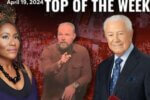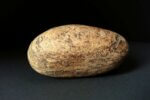Tired of people bashing “Christ’s-mass”? Well check out the rich meanings behind the symbols of the season.

Taking their cue from Old Testament Jewish celebrations and festivals, Christians developed their own feast day commemorating the event and called it “The Feast of the Nativity.” It was later called “Christ Mass” or “Christ’s Mass” and eventually shortened to “Christmas.”
Christmas is a significant “Christocentric” term because it calls to mind that the center of the celebration is Christ! A third century theologian said it well: “We hold this day holy, not like the pagans because of the birth of the sun, but because of Him who made it.”
Christ’s birthday. A widely held opinion is that Christ was not born on Dec. 25. Many believe we celebrate Christmas on December 25 because the third century church Christianized the date on which some pagan festivals were observed.
The truth is that Roman Emperor Aurelian passed an edict in A.D. 274 establishing the festival of Natalis Solis Invicti (Birthday of the Unconquerable Sun) while dedicating a temple. But such notable church fathers as Tertullian and Augustine were convinced that Christmas preceded this pagan holiday.
Alvin J. Schmidt, in his scholarly work Under the Influence, states that in northern Africa Christians were already celebrating the birth date of Jesus as Dec. 25 in A.D. 243, 30 years before Aurelian’s edict. If this is true, it wasn’t Christianity that Christianized a pagan festival but a pagan emperor attempting to paganize a Christian festival that predated it by 30 years.
Alfred Edersheim, one of the foremost scholars on ancient Jewish culture and sacred writings, disagrees with those who question Dec. 25 as the date of Christ’s birth. He states that “there is no adequate reason for questioning the historical accuracy of this date. The objections generally made rest on grounds, which seem to me, historically unfeasible.”
The shepherds watching their flocks by night. Another popular argument against Christ’s being born in December asserts that shepherds would not have their flocks out past October. Therefore, there weren’t any shepherds out in December. Is this true?
Edersheim claims there were shepherds at a place called Migdal Eder, near Bethlehem, who were commissioned by the Jewish priests to keep temple flocks in a specific pastureland year-round. Their demanding duties prevented them from participating in religious observances.
Taking as his source the Mishnah, the book of Jewish oral traditions, Edersheim writes that specific passages “lead us to infer that these flocks lay out all the year round.” The shepherds who watched them could not worship and learn about God at the temple, so God chose them to be the first ones to see His newborn Lamb.
Christmas trees. Trees are very important in Christian theology. The Bible begins with a tree (the tree of life in the Garden of Eden) and ends with a tree (the cross on which Jesus paid the price for our redemption).
Some have dismissed the display of Christmas trees as a pagan yuletide custom unfit for Christian usage. But evergreen trees are key in the biblical revelation of redemption and restoration.
According to the Bible, the first thing that happens as a consequence of sin is that the earth is cursed. Immediately thorns spring up, and from that time forward, thorns, briar and thistle become the biblical symbols of accursedness and barrenness because of sin. Later on, the Lord chooses pine trees as His chosen symbol for redemption and restoration.
Not just any tree was chosen for such a purpose but the evergreen tree family exclusively. In fact, evergreens are biblical metaphors for reversal: They symbolize divine reversal from a state of accursedness and judgment to a state of blessedness and restoration. God even identified Himself as a pine tree in Hosea 14:8.
Scriptures such as Isaiah 41:17-20, 55:10-13 and 60:13 name two to three species of evergreen trees as prophetic signs of God’s promise to reverse the curse over the land and usher in an age of blessing. The pine tree prefigured the cross (also referred to as a tree) as a symbol of redemption. Trees represent God’s “instead ofs” when speaking to a people under judgment.
“‘Instead of the thornbush will grow the pine tree, and instead of briers the myrtle will grow. This will be for the Lord’s renown, for an everlasting sign, which will not be destroyed'” (Is. 55:13, NIV, emphasis added).
Chrismons. “Chrismon” (pronounced KRIZ-mon) comes from the Latin word for monogram. A chrismon is a Christmas tree that has been purposely decorated with symbols that clearly point to the person and work of Christ and the biblical account of His incarnation.
In effect, a chrismon serves as a word picture, telling the story of Christ’s birth with its decorations. Chrismons emerged in 1957 when Frances Kipps Spencer, the daughter of a Lutheran minister, decorated her Lutheran church’s Christmas tree with centuries-old monograms and Christograms that pointed to the person and work of Christ. Many Christian homes today are intentionally making their Christmas celebrations more Christ-centered by turning their Christmas trees into chrismons.
The Paradise Tree. The first Christmas tree tradition probably emerged as a result of an 11th century play. In early times, Christian leaders taught illiterate converts the Bible by using drama and skits.
One of the most popular of these plays–The Paradise Tree–was performed on Christmas Eve. It dealt with creation and the sin of Adam and Eve, and ended with the prophecy in Genesis 3:15 of the future Deliverer.
The play was unusual because its only prop was a huge fir tree laden with apples placed in the middle of the stage. Earliest commentaries say that Eden’s “tree of life” was a fir tree, and the “tree of the knowledge of good and evil” was an apple tree. The focal point of the play was Eve’s taking a bite out of the forbidden fruit and giving it to Adam–actions that resulted in the fall of man.
Later on, Christian families set up paradise trees in their homes as symbols of redemption through the birth of Christ. Because of this close association with the work of Christ, the paradise tree became known as the redemption tree. At first apples, representing the fall, were secured to the branches of the tree. The tree itself symbolized the Savior.
As the redemption tree tradition developed, the apples were put into a basket at the foot of the tree, and sugar-coated fruit, candies and communion wafers were secured to the branches instead (representing the sweetness of the Savior and the fruit of His redemption). Soon there were so many fruits, candies and treats on the tree that its boughs were weighed down.
A German craftsman solved the problem by making glass-blown pieces of fruit that were much lighter than actual fruit. These became the artificial decorations we have today, derived from Christ-honoring Christmas traditions rooted in a desire to glorify Jesus.
Christmas greenery. God Himself, speaking through Isaiah, inspired the idea of using a variety of evergreen trees to decorate the sanctuary of the Lord: “‘The glory of Lebanon will come to you, the pine, the fir and cypress together, to adorn the place of my sanctuary; and I will glorify the place of my feet” (Is. 60:13).
By the 16th century, Western Christians were practicing the Christmas tradition of “greening” the church and home with evergreen trees, branches and cones. Laurel wreaths pointed to the victory of Christ. Holly and ivy later replaced laurel, carrying the idea of peace (because of the birth of Christ) and joy (because of the glad tidings of Christ).
The holly wreath, with its thorns and red berries, symbolized the crown of thorns, with the red berries representing the drops of Christ’s curse-reversing blood. That is why we deck those halls with boughs of holly!
The significance behind the Christian observance of Christmas lies in the person it celebrates. If our Christmas celebrations are to be more meaningful and filled with festive joy, Christ must become the forethought of everything we do instead of an afterthought.
So go all out with Christmas decorations, but use only those symbols and traditions that point to the Savior’s birth, person and work. Get out the crèche, golden horns, silver trumpets, harps and bells, angels, shepherds, stars and musical notes, lights and wreaths, and holly wreaths and evergreens. Let every decoration and tradition point to some aspect of Jesus Christ, who alone is the life of the party.
Peter Bertolero is a theologian and pastor of Fresno Christian Growth Center in Fresno, California. He and his wife, SueJae, have three teenagers. This article was adapted from his book GreenTree. For more information, write to the author at [email protected] .







Leave a Comment
You must be logged in to post a comment.